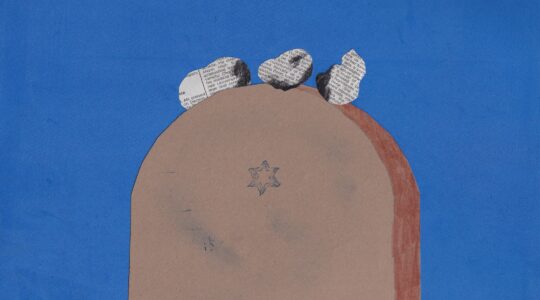LOS ANGELES (JTA) — On Oct. 29, 2008, the Israeli Supreme Court rendered a unanimous decision permitting the Simon Wiesenthal Center to resume construction on its Museum of Tolerance project on the site of the municipal parking lot in the heart of western Jerusalem. The court denied the contention of the project’s chief opponent, Sheik Raed Salah, a notorious anti-Semite and Hamas supporter, that the parking lot was a Muslim cemetery and allowed construction to resume even on the small portion where bones were found.
For half a century, hundreds of Jews, Christians and Muslims parked their cars every day on the site, with no protest whatsoever from any Muslim groups, religious leaders, nongovernmental organizations or professors.
As the court noted, “for almost 50 years the compound has not been a part of the cemetery, both in the normative sense and in the practical sense, and it was used for various public purposes." It also said, "During all those years no one raised any claim, on even one occasion, that the planning procedures violated the sanctity of the site, or that they were contrary to law as a result of the historical and religious uniqueness of the site." And, "For decades this area was not regarded as a cemetery by the general public or by the Muslim community."
"No one," the court said, "denied this position."
In 1964, the highest Muslim authority, the Muslim Religious Council, even ruled that the adjacent Independence Park (Mamilla Cemetery) was a "mundras," an abandoned site where building is permissible. Today, mundras is a widely relied-upon categorization and sanctioned throughout the Arab world — in Jordan, Lebanon, Egypt, Saudi Arabia and the Palestinian territories.
While traditional Judaism does not have such a concept, the court noted that “in practice, where public needs required this, an agreed Jewish law solution has usually been found, and this allowed the building to be carried out in a way that minimized … the violation of the graves."
Since the Israeli government and City of Jerusalem gave us the land eight years ago, the Wiesenthal Center has endured many checks and balances — planning and architectural meetings, City Council hearings, displaying the Frank Gehry model at Jerusalem City Hall, placing ads announcing the project in Hebrew, Arabic and English newspapers. During all these years, while tens of millions of dollars were being spent, not a single protest was heard. No scholar, ordinary citizen or government official argued that the site was a cemetery.
Why? Because they agreed with the court that "the area has not been classified as a cemetery for decades." The bones found during the excavation process were between 300 and 400 years old, unaccompanied by a single marker or monument identifying any individual name, family or religion.
Under the supervision of the Israel Antiquities Authority, the bones discovered will be treated with the utmost dignity and will be re-interred in accordance with Muslim tradition.
Jerusalem is more than 3,000 years old. Hardly a street or neighborhood is without relics or bones. We could declare it a cemetery, off limits to everyone — a city of the past with no future — or we could find a better way to revere the past without choking off the future.
Some recent critics such as Americans for Peace Now and the Council on American-Islamic Relations argue that the museum should set a higher standard. We have. Even though our opponents deliberately watched our project move forward without protesting, our lawyers still attempted to meet with Sheik Salah but were rebuffed. The court’s own mediator tried but fared no better. We offered practical solutions to build on top of the bones without disturbing them — also rejected. We offered to restore the virtually abandoned nearby Mamilla Cemetery — they were not interested.
The sheik had one objective — to declare this site in western Jerusalem a Muslim site. He himself chose the venue of the Supreme Court but is unwilling to accept and abide by its unanimous decision. The Museum of Tolerance will not allow itself to fall victim to intimidation and intolerance.
Fortunately, many Israeli and Jewish leaders have endorsed our project: Prime Minster Ehud Olmert; former Prime Minister Benjamin Netanyahu; the executive vice-chairman of the Conference of Presidents of Major American Jewish Organizations, Malcolm Hoenlein; Harvard Law School professor Alan Dershowitz; former Canadian Justice Minister Irwin Cotler; the chairman of AIPAC’s board, Howard Friedman; respected journalist Ehud Ya’ari; and a former adviser to the late Prime Minister Yitzhak Rabin, Eitan Haber. (Visit www.wiesenthal.com to see all videotaped endorsements.)
It is important to understand that the court’s findings clearly indicate that its decision was moral as well as legal.
"The importance and benefit of … the plan to build the Museum of Tolerance in the center of the city of Jerusalem are very great," the court said. It said the museum "embodies an ideal of establishing a spiritual center that will spread a message of human tolerance between peoples" and that the location "has special significance" in a city "for three religions and an ancient history, which is unique to human civilization."
The museum site has been a public facility since 1960. It will never return to what it may have been 300 years ago. Seeing millions of people, young and old, Jews and non-Jews, arriving there to immerse themselves in the principles of mutual respect and social responsibility, is the very best kind of public-use facility that Jerusalem and the State of Israel needs at this time.
(Rabbi Marvin Hier is the founder and dean of the Simon Wiesenthal Center and its Museum of Tolerance.)
JTA has documented Jewish history in real-time for over a century. Keep our journalism strong by joining us in supporting independent, award-winning reporting.





